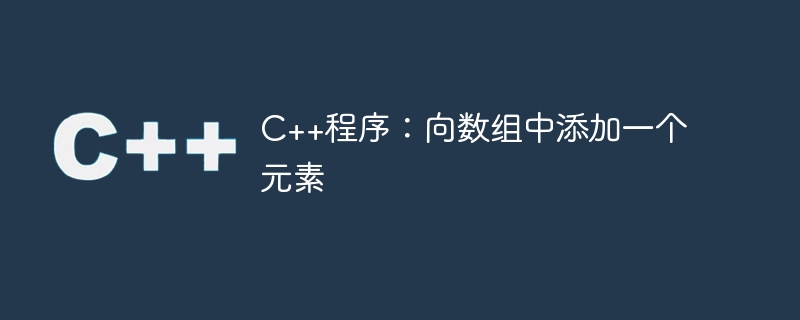
数组是一种线性顺序数据结构,用于在连续的内存位置中保存同质数据。与其他数据结构一样,数组也必须具备以某种有效方式插入、删除、遍历和更新元素的功能。在 C++ 中,我们的数组是静态的。 C++ 中还提供了一些动态数组结构。对于静态数组,该数组内可能存储 Z 个元素。到目前为止,我们已经有 n 个元素了。在本文中,我们将了解如何在 C++ 中在数组末尾插入元素(也称为追加元素)。
‘this’关键字的使用方式如下
Given array A = [10, 14, 65, 85, 96, 12, 35, 74, 69] After inserting 23 at the end, the array will look like this: [10, 14, 65, 85, 96, 12, 35, 74, 69, 23]
在上面的示例中,假设我们有一个数组 A,其中最多可以容纳 50 个元素。所以,Z 的值为 50。现在首先考虑一下,其中有 9 个元素。因此,数组的大小 n 为 9。要在数组末尾插入另一个元素,在我们的示例中为 23。该元素将被放置在末尾,并且 A 中的元素数量将增加 1。因此 n 变为 10。由于我们是在末尾插入,所以过程很简单。我们可以简单地在所有元素之后添加新元素,而无需更改数组中任何现有元素的位置。现在让我们看看该算法以及 C++ 实现代码,以便清楚地理解。
以数组 A 作为输入,元素数量 n 作为输入,以及将插入到 A 中的元素 e
立即学习“C++免费学习笔记(深入)”;
如果n是 A[ n ] = e 所谓数组,就是相同数据类型的元素按一定顺序排列的集合,就是把有限个类型相同的变量用一个名字命名,然后用编号区分他们的变量的集合,这个名字称为数组名,编号称为下标。组成数组的各个变量称为数组的分量,也称为数组的元素,有时也称为下标变量。数组是在程序设计中,为了处理方便, 把具有相同类型的若干变量按有序的形式组织起来的一种形式。这些按序排列的同类数据元素的集合称为数组。 数组应用&二维数组目录 1. 数组的简单应用2. 数组排序3. 数组查找4. 数组的使用思想5. 查表法6. 二维数组7. 数组综合

 0
0

结束如果
将 n 增加为 n := n + 1
返回数组 A 和新大小 n
#include <iostream>
# define Z 50
using namespace std;
void displayArr(int arr[], int n){
for( int i = 0; i < n; i++ ){
cout << arr[ i ] << ", ";
}
cout << endl;
}
void insertAtEnd( int arr[], int &n, int e ){
if( n < Z ) {
arr[ n ] = e;
}
n = n + 1;
}
int main() {
int arr[ Z ] = {57, 10, 14, 19, 86, 52, 32, 14, 76, 65, 32, 14};
int n = 12;
cout << "Array before insertion: ";
displayArr( arr, n );
cout << "Inserting 58 at the end:" << endl;
insertAtEnd( arr, n, 58 );
cout << "Array after insertion: ";
displayArr( arr, n );
cout << "Inserting 225 at the end:" << endl;
insertAtEnd( arr, n, 225 );
cout << "Array after insertion: ";
displayArr( arr, n );
}
Array before insertion: 57, 10, 14, 19, 86, 52, 32, 14, 76, 65, 32, 14, Inserting 58 at the end: Array after insertion: 57, 10, 14, 19, 86, 52, 32, 14, 76, 65, 32, 14, 58, Inserting 225 at the end: Array after insertion: 57, 10, 14, 19, 86, 52, 32, 14, 76, 65, 32, 14, 58, 225,
向量是 C++ STL 附带的动态数据结构。我们也可以获得类似的功能,例如向量中的数组。在向量内部,我们使用 push_back() 函数获得在末尾插入的功能。 push_back 函数将新元素作为参数,并将该元素插入到给定向量的末尾。该算法很简单。我们不需要做任何特殊的事情,只需通过传递我们要插入的新元素来调用给定向量对象的函数即可。我们直接看C++的实现。
#include <iostream>
#include <vector>
# define Z 50
using namespace std;
void displayArr( vector<int> v ){
for( int i = 0; i < v.size() ; i++ ){
cout << v[ i ] << ", ";
}
cout << endl;
}
vector<int> insertAtEnd( vector<int> A, int e ){
A.push_back( e );
return A;
}
int main() {
vector<int> A = {57, 10, 14, 19, 86, 52, 32, 14, 76, 65, 32, 14};
cout << "Array before insertion: ";
displayArr( A );
cout << "Inserting 58 at the end:" << endl;
A = insertAtEnd( A, 58 );
cout << "Array after insertion: ";
displayArr( A );
cout << "Inserting 225 at the end:" << endl;
A = insertAtEnd( A, 225 );
cout << "Array after insertion: ";
displayArr( A );
}
Array before insertion: 57, 10, 14, 19, 86, 52, 32, 14, 76, 65, 32, 14, Inserting 58 at the end: Array after insertion: 57, 10, 14, 19, 86, 52, 32, 14, 76, 65, 32, 14, 58, Inserting 225 at the end: Array after insertion: 57, 10, 14, 19, 86, 52, 32, 14, 76, 65, 32, 14, 58, 225,
数组是连续保存同质数据的最简单的数据结构之一。数组是数据结构。与其他数据结构一样,我们也可以轻松地插入、删除、更新和遍历数组元素。在本文中,我们看到了两种在末尾插入元素的方法,换句话说,将元素追加到数组中。在第一个方法中,我们在 C++ 中使用静态数组。由于我们的目标是结束位置,因此不需要移动数组中的任何元素,只需在最后一个索引处添加一个新元素,并增加总项目计数参数以供进一步使用。在第二种情况下,我们使用向量。向量就像 C++ 中的普通数组,但它们本质上是动态的。它会在需要时自动更新其总大小。 C++ STL 支持向量,向量有一个名为 push_back() 的特殊函数,用于在后面插入元素。但是,我们不能用这种简单直接的方法在开头添加元素。
以上就是C++程序:向数组中添加一个元素的详细内容,更多请关注php中文网其它相关文章!

c++怎么学习?c++怎么入门?c++在哪学?c++怎么学才快?不用担心,这里为大家提供了c++速学教程(入门到精通),有需要的小伙伴保存下载就能学习啦!

Copyright 2014-2025 https://www.php.cn/ All Rights Reserved | php.cn | 湘ICP备2023035733号